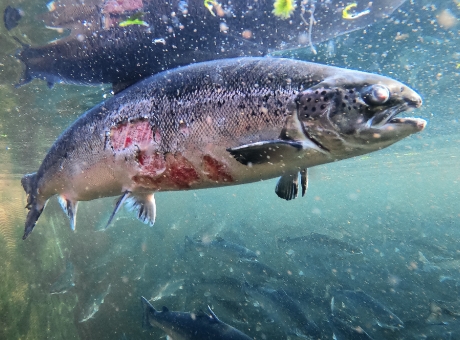Unless all salmon farms are legally compelled to control sea lice to very low levels in as close to real time as possible, then the future for wild salmon and sea trout in Scotland’s salmon farming areas will remain very bleak.
Unless all salmon farms are legally compelled to control sea lice to very low levels in as close to real time as possible, then the future for wild salmon and sea trout in Scotland’s salmon farming areas will remain very bleak.
Since March 2021 the Scottish Government has required the weekly reporting and publication of average sea lice prevalence on fish farms in Scotland. This information is published here.
We also compile weekly sea lice statistics which can be viewed by clicking the button below
View
SITE_NAME (MS names):
Transcribed directly. Marine Scotland name used for site at geographic location
BUSINESS_NAME:
Transcribed directly. Marine Scotland name used for operator of site at geographic location
AV_FEMALE_SEA_LICE_PER FISH:
Transcribed directly from report: https://scottishepa.maps.arcgis.com/apps/webappviewer/index.html?id=2218824350e5470e8026076d4138da58
NB: Notwithstanding existing criticism of flawed reporting regime for sea lice data generated by salmon farms
BREACH OF COGP:
Value created by Database Admin. (If AV_FEMALE_SEA_LICE_PER FISH >= 1.01) reported as “YES”
LOCAL DSFB:
TO BE ADDED
WEEK_NO:
Transcribed directly from report: https://scottishepa.maps.arcgis.com/apps/webappviewer/index.html?id=2218824350e5470e8026076d4138da58
WEEK_BEGINNING:
Transcribed directly from report: https://scottishepa.maps.arcgis.com/apps/webappviewer/index.html?id=2218824350e5470e8026076d4138da58
MITIGATION:
Transcribed directly from report: https://scottishepa.maps.arcgis.com/apps/webappviewer/index.html?id=2218824350e5470e8026076d4138da58
ADDITIONAL_INFORMATION:
Transcribed directly from report: https://scottishepa.maps.arcgis.com/apps/webappviewer/index.html?id=2218824350e5470e8026076d4138da58
WKS IN BREACH OF COGP:
IN DEVELOPMENT
NO. OF HOSTS:
IN DEVELOPMENT
BIOMASS:
IN DEVELOPMENT
DSFB CONTACT:
TO BE ADDED
MONTHS IN PRODUCTION:
Value created by Database Admin. Accurate (+/- 2months) (The SG does not record when production cycles begin or end, so this has to be taken from signals in other data, which is inconsistent.) Over time this will become 100% accurate as the commencement or cessation of data being reported under sea lice reporting should provide a primary indicator.
Notes:
The integrity of Environmental Management Plans and adaptive management, as mechanisms to protect wild salmon and sea trout from lethal infestation by sea lice from salmon farms, is entirely dependent on farms recording accurate sea lice numbers. However, there are increasing concerns and evidence that sea lice numbers published by farms are either inaccurate and/or under-recorded. The system is subject to abuse and manipulation and counts are not standardised. The situation is exacerbated by the fact that there is no regular independent verification. Without confidence in the veracity of on-farm lice counts, the viability of current EMPs and any future adaptive management (as envisaged by the Salmon Interactions Working Group) lies in tatters.
To have real and consistent value, the weekly sea lice figures reported by fish farms require standardisation and regular independent verification by statutory bodies.
Find Out MoreIn the west Highlands and Islands of Scotland, which play host to over 200 salmon farms (producing over 200,000 tonnes of farmed salmon annually), sea lice represent a lethal threat, almost certainly the most lethal threat, to the survival of wild salmon and sea trout.
Background levels of sea lice parasites occur naturally in the sea. However, the arrival and exponential expansion of salmon farming, particularly in fjordic or largely enclosed sea lochs, has caused to a fundamental change in the density and occurrence of sea lice in the coastal waters of the west Highlands and Islands. Even one or two mature female sea lice per fish within a set of cages housing hundreds of thousands of farmed salmon amount to a very large breeding reservoir producing huge numbers of mobile juvenile sea lice that move out into the local marine environment.
The consequences for wild salmon and sea trout smolts, the metamorphosing fragile skin of which is not adapted to cope with more than a few lice, as they migrate from local rivers to sea, can be devastating. Lice feed by grazing on the surface of the fish and eating the mucous and skin. Large numbers of lice soon cause the loss of fins, severe scarring, secondary infections and, in time, death. Badly infested wild salmon smolts disappear out to sea, never to be seen again. In contrast afflicted sea trout smolts remain within the locality and they, together with the impact of the deadly burdens they carry, are more easily monitored.
Photos used on this page are kindly supplied by ©CorinSmith.
Support like yours allows our determined campaigning team to fight the destruction caused by open-net salmon farming, pollution and over-abstraction
Find out about all the ways in which you can help wild fish…

